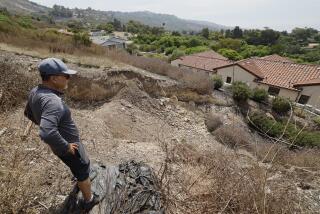Quake’s a Wake-Up Call on Water : Canals, aqueducts, pipelines that carry 90% of county’s water could be damaged
The earthquakes and aftershocks that rumbled across Southern California this week should remind San Diegans just how tenuous our hold is on a precious commodity: water. Had the quakes--including the strongest temblor in 40 years--rolled down the San Andreas or Elsinore faults, thousands of spigots in North County could have run dry within 48 hours.
All or part of the canals, aqueducts and pipelines that provide 90% of the county’s water supply could have been devastated, creating an almost instant crisis. Fortunately, the San Diego County Water Authority is actively seeking sites for new or expanded reservoirs that could supply water in an emergency.
Some special-interest groups that oppose proposed sites for various reasons are already scurrying to familiar political corners and threatening to stifle a full debate on this critical issue. That can’t be allowed to happen. Unlike a similar debate several years ago over transforming Pamo Valley into a reservoir, this effort must start with everything on the table and everyone given a chance to have their say.
The need for additional emergency storage space is undeniable. CWA officials estimate that, if San Diego suddenly was cut off from the water provided by the Metropolitan Water District in Los Angeles, the county would be nearly 40,000 acre-feet short of emergency needs. That’s enough water to supply 80,000 households for an entire year.
And, given current growth trends, the water deficit is expected to rise to 143,000 acre-feet by the year 2030. A break in local--instead of MWD--pipelines could bring a 72,000 acre-feet shortage now and a 110,000 acre-feet deficit by 2030, shortages that could linger for six months.
And no one can deny that our web of water sources is vulnerable. The MWD system crosses the San Andreas fault six times. Local pipelines cross the Elsinore fault five times within 7 miles of each other. The Colorado River aqueduct flows over three fault lines. And earthquakes aren’t the only hazards; heavy flooding could also wipe out access to water imports.
Once again, the most controversial site is Pamo Valley, despite the fact that the land is already government-owned and voters have approved a bond issue to build a 264-foot concrete dam there. Indeed, the city purchased the land in 1928 as a perfect site for a future reservoir.
But environmental concerns about flooding this pristine valley are legitimate. Inundating it would destroy 1,339 acres of wildlife habitat that is home to at least one endangered species, the least Bell’s vireo.
The four other options under consideration by CWA--Moosa Canyon, Guejito Valley, San Vicente reservoir and Lake Wohlford--deserve careful scrutiny before the debate once again focuses on Pamo Valley. But all those sites have their down sides, too--less capacity, higher costs, the need to force people from their homes or flood Indian burial grounds.
In short, there are no painless solutions. But the need is real. And, in the fullness of public debate about all five options, an answer can emerge--if all sides come to the table with an open mind.
More to Read
Sign up for Essential California
The most important California stories and recommendations in your inbox every morning.
You may occasionally receive promotional content from the Los Angeles Times.










